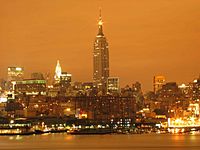Light pollution facts for kids
Light pollution happens when there's too much artificial (man-made) light. It's a type of pollution that can cause bad effects. This often means lights are too bright or used when they aren't needed. Many living things, including plants and people, are harmed by light pollution. It also costs a lot of money every year.
Contents
What Are the Types of Light Pollution?

There are five main types of light pollution. Each one describes a different way that too much light can be a problem:
- Light trespass
- Over-illumination
- Clutter
- Glare
- Sky glow
These types of light pollution can affect people and the environment in different ways.
Understanding Sky Glow
Sky glow is when the night sky looks bright because of lights from cities below. This glow makes it hard to see stars and planets. It stops birds from finding their way when they migrate. Birds use the moon and stars to navigate. Sky glow also makes it difficult for astronomers to study space.
What is Light Trespass?
Light trespass happens when light from one property shines onto another. For example, a bright street light might shine into your bedroom window. Even though it doesn't directly harm the environment, it's still a form of light pollution. It can be annoying and disturb people.
Dealing with Glare
Glare is when bright lights make it hard to see or cause discomfort. There are two main kinds of glare:
- Disability glare means you can't see properly because lights are too bright.
- Discomfort glare means the lights cause pain or irritation to your eyes.
How Light Pollution Affects Us
Light pollution has several negative impacts on both animals and humans.
Effects on Animals
Light pollution causes big problems for animals. Migrating birds rely on the moon and stars to find their way. Bright city lights can confuse them, making them fly off course. Sea turtles also suffer. Baby sea turtles hatch on beaches and naturally move towards the ocean's light. City lights can make them go the wrong way, away from the water. This makes them easy targets for predators.
Effects on Humans
Too much light at night can mess with our sleep. If bright lights shine into your home, it can stop you from getting enough rest. This can lead to headaches and other health issues. Light pollution also affects science. Astronomers need dark skies to study stars and galaxies. When the sky is too bright, it's hard for them to make new discoveries.
Finding Solutions to Light Pollution
Many people and groups are working to reduce light pollution. You can help too!
Working Together: Group Solutions
People started noticing light pollution as a serious issue in the 1960s. In 2002, the Czech Republic passed the world's first law against light pollution. Since then, more people are realizing that light pollution is a big problem. Many groups are now trying to find ways to use light more wisely. They work to protect dark skies for everyone.
What You Can Do: Individual Solutions
You can help reduce light pollution right from your home.
- Turn off lights when you don't need them.
- Use curtains or blinds on windows to block out disturbing lights from outside.
- Choose outdoor lights that point downwards, so light doesn't shine up into the sky.
Images for kids
-
A light pollution source, using a broad spectrum metal halide lamp, pointing upward at Uniqema factory, Gouda, the Netherlands
-
The city of Phoenix, seen from 55 miles away in Surprise, Arizona
-
An office building is illuminated by high-pressure sodium (HPS) lamps shining upward. Much light goes into the sky and neighboring apartment blocks, causing light pollution.
-
The Las Vegas Strip displays excessive groupings of colorful lights. This is a classic example of light clutter.
-
Streetlights at the ski resort Kastelruth in South Tyrol, Italy
-
The constellation Orion, imaged at left from dark skies, and at right from within the Provo/Orem, Utah metropolitan area
-
The Atacama Desert in northern Chile is far from any cities, and the night sky there is pitch-black. Photo by José Francisco Salgado.
-
Crossroad in Alessandria, Italy: luminaires with mercury lamps are in the background, LED street lights in the middle, luminaires with high pressure sodium lamps are in the foreground.
-
Black level compensation: the darkest point in the digital picture was set to zero luminance, in order to reduce the visible stray light. However, blue light caused by Rayleigh scattering is visible in the center of the image.
-
A comparison of the view of the night sky from a small rural town (top) and a metropolitan area (bottom). Light pollution dramatically reduces the visibility of stars.
-
Impact of light pollution on a starry night, as seen from a 4200 m altitude on Mount Damavand in Iran.
See also
 In Spanish: Contaminación lumínica para niños
In Spanish: Contaminación lumínica para niños

























